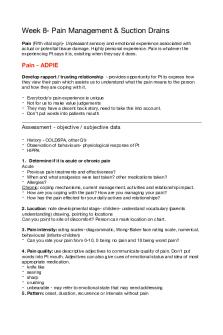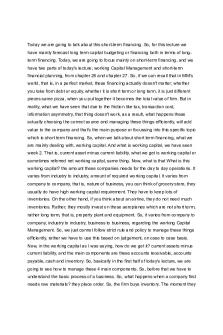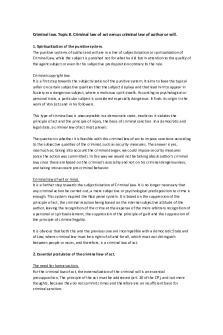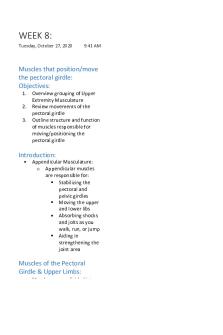Phys 103 chap 8 - Lecture notes 8 PDF

| Title | Phys 103 chap 8 - Lecture notes 8 |
|---|---|
| Course | How Things Work |
| Institution | Towson University |
| Pages | 3 |
| File Size | 65.6 KB |
| File Type | |
| Total Downloads | 89 |
| Total Views | 185 |
Summary
What is Energy?...
Description
What is energy? Energy??? I stole my energy story from the famous American physicist Richard Feynman. Here is a version adapted from his original energy story. He used the character, "Dennis the Menace." The story below is paraphrased from the original Feynman lecture on physics (in the early 1960s). Dennis the Menace Adapted from Richard Feynman
Imagine Dennis has 28 blocks, which are all the same. They are absolutely indestructible and cannot be divided into pieces.
His mother puts him and his 28 blocks into a room at the beginning of the day. At the end of each day, being curious, she counts them and discovers a phenomenal law. No matter what he does with the blocks, there are always 28 remaining. This continues for some time until one day she only counts 27, but with a little searching she discovers one under a rug. She realizes she must be careful to look everywhere. One day later she can only find 26. She looks everywhere in the room, but cannot find them. Then she realises the window is open and two blocks are found outside in the garden. Another day, she discovers 30 blocks. This causes considerable dismay until she realizes that Bruce has visited that day, and left a few of his own blocks behind. Dennis' mother removes the extra blocks, gives the remaining ones back to Bruce, and all returns to normal. We can think about energy in this way (except there are no blocks!). We can use this idea to track energy transfers during changes. We need to be careful to look everywhere to ensure that we can account for all of the energy. Some ideas about energy
Energy is stored in fuels (chemicals). Energy can be stored by lifting objects (potential energy). Moving objects carry energy (kinetic energy). Electric current carries energy. Light (and other forms of radiation) carries energy. Heat carries energy.
Sound carries energy.
But is energy a real thing? No, not exactly. It is a mathematical concept, completely consistent with Newton's laws and the equations of motion. It allows us to see that some number (calculated according to other manifest changes - speed, mass, temperature, position, etc.) remains constant before and after some "event" occurs. Conservation of Energy The central idea of most science can be expressed as follows:
Energy is neither created nor destroyed - it only changes forms.
This is to say that energy, if expressed mathematically, is the same before and after some "event" occurs, as long as we keep track of ALL of the energies in the system. (Just like the blocks in Feynman's example above.) Many things can be thought of as energy problems: In chemistry: - balancing chemical equations is an energy concept - PV = nRT is an energy relationship - conservation of mass is related In biology: - photosynthesis - how animals eat/consume food - how anything grows - Calorie counting as related to weight loss/gain is an energy endeavor In physics: - Laws of thermodynamics - how we think of electricity in circuits - falling bodies - orbits - things swinging back and forth (oscillations) - wave motion
Virtually everything in science can be discussed in terms of energy. Furthermore, energies are or two major types:
Potential energy - energy of position/location Kinetic energy - energy of motion Any energy that you can imagine can be thought of as either a potential energy or kinetic energy. This isn't always easy, but they can always be quantified and "tracked" through changes. If energy seems to have been lost, it simply was transferred to something less easy to locate....
Similar Free PDFs

Chap 8 Lecture Notes
- 10 Pages

8 - Lecture notes 8
- 21 Pages

8 - Lecture notes 8
- 21 Pages

Notes Bioch - Chap 8
- 7 Pages

Chap 8 part 1 - Lecture notes 4
- 4 Pages

8 Midwifery - Lecture notes 8
- 3 Pages

Taxation 8 - Lecture notes 8
- 2 Pages

Week 8 - Lecture notes 8
- 6 Pages

Dox 8 - Lecture notes 8
- 21 Pages

Lesson 8 - Lecture notes 8
- 2 Pages

Assignment 8 - Lecture notes 8
- 4 Pages

Week 8 - Lecture notes 8
- 23 Pages

WEEK 8 - Lecture notes 8
- 10 Pages
Popular Institutions
- Tinajero National High School - Annex
- Politeknik Caltex Riau
- Yokohama City University
- SGT University
- University of Al-Qadisiyah
- Divine Word College of Vigan
- Techniek College Rotterdam
- Universidade de Santiago
- Universiti Teknologi MARA Cawangan Johor Kampus Pasir Gudang
- Poltekkes Kemenkes Yogyakarta
- Baguio City National High School
- Colegio san marcos
- preparatoria uno
- Centro de Bachillerato Tecnológico Industrial y de Servicios No. 107
- Dalian Maritime University
- Quang Trung Secondary School
- Colegio Tecnológico en Informática
- Corporación Regional de Educación Superior
- Grupo CEDVA
- Dar Al Uloom University
- Centro de Estudios Preuniversitarios de la Universidad Nacional de Ingeniería
- 上智大学
- Aakash International School, Nuna Majara
- San Felipe Neri Catholic School
- Kang Chiao International School - New Taipei City
- Misamis Occidental National High School
- Institución Educativa Escuela Normal Juan Ladrilleros
- Kolehiyo ng Pantukan
- Batanes State College
- Instituto Continental
- Sekolah Menengah Kejuruan Kesehatan Kaltara (Tarakan)
- Colegio de La Inmaculada Concepcion - Cebu


